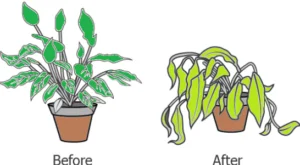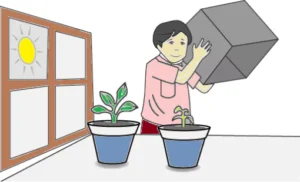Hint: Summarize the key features of living organisms that contribute to their survival in their habitats.
Question.1. Animals like a camel can survive in a desert. Which of these features in the camel helps them to survive in the desert?
(a) Hump of the camel produces food
(b) Long neck help to store more water
(c) Long legs protect them from heat of the sand
(d) Thicker skin help in the transpiration of more water
Question.2. Animals like polar bears living in cold regions have long hairs in their body. How do these hairs help an animal to survive in a cold region?
(a) It keeps their body warm
(b) It helps an animal to run faster
(c) It helps the animal to swim in water
(d) It absorbs water from the atmosphere
Ans.1. (c) Long legs protect them from heat of the sand
Ans.2. (a) It keeps their body warm
Hint: Differentiate between terrestrial & aquatic habitats based on abiotic factors.
Question.3. A list of few abiotic components are provided in the table.
(a) 


Question.4. The table list a few abiotic components and its availability in different habitats.
(a) Only Light
(b) Only Gases
(c) Both light and temperature
(d) Both gases and temperature
Ans.3. (c)
Ans.4. (c) Both light and temperature
Hint: Devise an experiment to show the importance of abiotic factors for the growth
& sustenance of life on earth.
Question.5. The image shows a plant it was left near a sunny window un-attended for few weeks.
(a) Water is essential for plants to survive
(b) Presence of water makes the leaf green
(c) Plants grow stronger in the absence of water
(d) Plants can absorb water from the atmosphere
Question.6. A student performs an experiment where he planted two similar plants on two different pots. He covered one of them with a carton and placed the other plant close to the window. He provide equal amount of water to both of them. After 10 days the result in the growth of the plants is shown in the image.
(a) Plants produces its own food
(b) Plants require sunlight to grow
(c) Plants can survive without air and water
(d) Growth of a plant depends only on water supply
Ans.5. (a) Water is essential for plants to survive
Ans.6. (b) Plants require sunlight to grow
Hint: Identify the function of different physical feature that assist inhabitants to survive in harsh conditions.
Question.7. When a person from the plains visits the mountains for the first time, they experience shortness of breath. This changes over the next few days as a person gets adapted. What happens in this process of adaptation?
(a) The body undergoes an allergic reaction which later subsides
(b) The body adjusts its breathing according to the air of the new habitat
(c) The person feels homesickness but later gets used to being away from home
(d) The person gets used to the different flora and fauna of mountain habitats
Question.8. A cactus in a desert lacks leaf. Instead of leaves, it’s thick stem is responsible for photosynthesis. Why are leaves absent in these plants?
(a) Leaves would have wilted easily in the strong desert Sun
(b) Leaves are absent in cactus plants to save them from predators
(c) Leaves would have caused increased loss of water from the plant
(d) Leaves are reduced to spines to protect from cold nights in the desert
Ans.7. (b) The body adjusts its breathing according to the air of the new habitat
Ans.8. (c) Leaves would have caused increased loss of water from the plant
Hint: Explore various adaptive features of different organisms in their habitats.
Question.9. Snakes do not have protective modifications like Camels and Coyotes, to survive under the hot desert Sun for a long time. How are they considered a part of a desert’s biodiversity?
(a) They only reside in a desert wherever there is an oasis
(b) They have a slimy coating which makes it easier for them to slither
(c) They are nocturnal and mostly stay deep underground during the day
(d) They are less mobile in a desert and feed off whatever is available nearby
Question.10. In an aquatic habitat, fish have streamlined bodies and respire underwater through their gills. However, mammals such as dolphins and whales also live in such habitats, but they do not have gills. How can they survive in aquatic habitats alongside fish?
(a) They respire through their skin
(b) They absorb the gases dissolved in the water they consume
(c) They absorb gases through the membranes present in their fins
(d) They hold their breath underwater and come up to breathe air via nostrils
Ans.9. (c) They are nocturnal and mostly stay deep underground during the day
Ans.10. (d) They hold their breath underwater and come up to breathe air via nostrils
Hint: Examine the idea that the absence of any one feature or characteristic of a habitat might not affect to balance.
Question.11. A small lake was present at one end of a forest. Over the years, the lake dried up. What effect would this have had on the habitat and diversity of the forest?
(a) The amphibians from the lake would start living on dry land
(b) Absence of the lake would slowly turn the forest habitat barren
(c) Terrestrial plants and animals would inhabit the land where the lake was
(d) Only small terrestrial mammals would occupy the marshland left by the lake
Question.12. In a grassland, if one species of herbivores were to be extinct over the years, what effect would it likely have on the habitat?
(a) Other herbivores would also slowly go extinct and only predators would remain
(b) Another herbivore’s population would grow and be stabilized by predators
(c) Grasses would grow uncontrollably and spread into the adjacent habitat
(d) The predator population would also slowly become extinct
Ans.11. (c) Terrestrial plants and animals would inhabit the land where the lake was
Ans.12. (b) Another herbivore’s population would grow and be stabilized by predators
Hint: Apply knowledge of life processes in studying a specimen for signs of life.
Question.13. A child has trouble in understanding that all plants are living organisms, just like humans. Since they cannot move around like humans, other animals, birds and fish, what can be told to the child, that would make him consider that plants are also living things, like humans?
(a) Plants can absorb water from the soil
(b) Plants are present in large numbers and variety
(c) Plants can reproduce and create other young plants
(d) Plants are found in both, terrestrial and aquatic habitats
Question.14. A grain of wheat cannot move, photosynthesise its food or grow without conditions like soil, sunlight, water, minerals, etc. Can a seed be considered a living thing?
(a) Yes, because it a product obtained from plants
(b) No, because it cannot survive on its own
(c) Yes, because seeds can respire
(d) No, because a seed is dormant
Ans.13. (c) Plants can reproduce and create other young plants
Ans.14. (c) Yes, because seeds can respire





